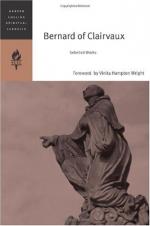|
This section contains 4,403 words (approx. 15 pages at 300 words per page) |

|
SOURCE: Renna, Thomas. “Bernard and Bede.” American Benedictine Review 44, no. 3 (September 1993): 223-35.
In the following essay, Renna compares Bernard's outlook regarding the goals and function of monks to that of the Anglo-Saxon Bede.
Bede and Bernard. The one, the great monastic illuminary from Anglo-Saxon England; the other, from twelfth-century France. They lived at two important junctures in the development of Western monasticism. Modern historians have generally emphasized Bede's place in the Northumbrian renaissance, and Bernard's role in the monastic reforms after 1100. Bernard is sometimes contrasted with Benedict of Nursia, Benedict of Aniane, Cluniacs, or thirteenth-century Franciscans in order to discern his distinctive qualities. How do Bede and Bernard reflect their respective monastic environments? Is there something peculiarly English about Bede or French about Bernard? It will be argued here that their respective goals for the function of monks were shaped by the state of monasticism at the time...
|
This section contains 4,403 words (approx. 15 pages at 300 words per page) |

|


